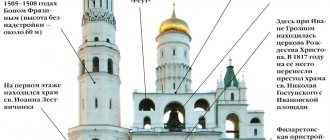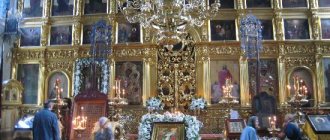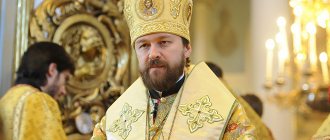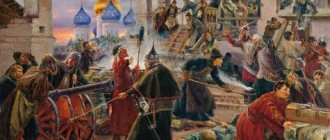The highest hipped bell tower and tiles on the facade: what else is valuable about St. Nicholas Church in Khamovniki
Experts have approved the protection of the ensemble of the Church of St. Nicholas in Khamovniki with a refectory and fence, which is located on the corner of Komsomolsky Prospekt and Lev Tolstoy Street.
The temple was built in 1679–1682 in the settlement of the royal weavers (Khamovniki). The consecration of the temple took place on June 25, 1682 under Tsar Fyodor Alekseevich.
By 1694, the refectory with chapels and the bell tower were completed - this is how the Church of St. Nicholas the Wonderworker in Khamovniki acquired the appearance we know. In 1845, wall paintings appeared in the church.
“The ensemble of the Church of St. Nicholas in Khamovniki is one of the symbols of the region. The design of the façades of the church also contains features of the Naryshkin Baroque, but the main value of its external decoration is the numerous tiles abundantly used on the facades: green tiles inserted three pieces into each kokoshnik of the main church, as well as multi-colored glazed tiles in the flies of the hipped bell tower. These and other unique elements were included in the subject of protection,” commented the head of the capital’s Department of Cultural Heritage, Alexey Emelyanov.
The bell tower of this temple is one of the tallest tented bell towers in Moscow. Her tent is decorated with 32 dormer windows.
On the north wall of the church there are stone gravestone tablets from the 18th century, reminiscent of the fact that there was a parish cemetery here.
Project for the protection of a cultural heritage site of federal significance “The Church of St. Nicholas in Khamovniki. Refectory. Ograda" was developed on the basis of historical and cultural research and takes into account the features of the object that served as the basis for its inclusion in the unified register of cultural heritage objects. It takes into account, in particular, the unique architectural and artistic design of the facades and interiors of the church of the second half of the 17th, early 18th - 19th centuries, including oil painting of the second half of the 19th century and artistic metal.
Built in the 80s of the 19th century, the temple fence includes openwork metal gratings with floral patterns, pillars with spherical tops and the entrance gates of the church complex decorated in the style of the 17th century. All of them are also included in the subject of protection of the ensemble approved by the order of the Moscow City Heritage.
In the twentieth century, St. Nicholas Church did not close and retained its decoration almost untouched. The church is one of the best examples of Moscow architecture of the 17th century in the marvelous pattern style.
Now all restoration work will be carried out taking into account the approved subject of protection.
Recently, the Moscow City Heritage Agency approved the subject of protection for another architectural monument in Khamovniki - the Church of St. Nicholas the Wonderworker (on Bolvanovka). The temple of the 17th–18th centuries is located at the address: Verkhnyaya Radishchevskaya street, house 20, building 2.
This is a five-domed, two-story temple with a bell tower and a refectory. Initially, on the ground floor there was a so-called warm, heated church for winter services, and on the second floor there was a summer church with the altar of the apostles Peter and Paul. Now there is no such division.
This is a five-domed, two-story temple with a bell tower and a refectory. Initially, on the ground floor there was a so-called warm, heated church for winter services, and on the second floor there was a summer church with the altar of the apostles Peter and Paul. Now there is no such division.
Experts recognized the external decoration of the temple as valuable. These are half-columns with white stone bases, capitals, flies (a square or rectangular recess in the wall, decorated with a multi-stage frame) with tiles, a white stone plinth, belts with crackers - a carved cornice edged with teeth. The roofs and domes of the temple with crosses were also included in the subject of protection. The interior details of the 17th–18th centuries were also considered valuable—half-columns and pilasters (flat columns), as well as the white stone paved floor.
Temple-Bell Tower
In Russian church architecture in the 15th-16th centuries, bell churches were popular.
“Izhe pod bells (“which is under the bells”) is an architectural type of temple in which a ringing tier is built immediately above the temple premises.
The Church-Bell Tower of the Holy Blessed Prince Igor of Chernigov and Kyiv, in Toksovo, Leningrad region, was built in our days and was consecrated on October 14, 2009 on the Feast of the Intercession of the Blessed Virgin Mary in honor of the Prince of Chernigov.
I Igor Olgovich Chernigovsky
, in baptism
George
, in monasticism
Gabriel
, in schema
Ignatius
(+ 1147), holy noble Grand Duke of Kiev, passion-bearer. His Kiev principality lasted only two weeks at a time when Rus' was torn apart by internecine warfare between the Olgovichs and Mstislavichs for the Kiev throne. He was captured, then took monastic vows and completely devoted himself to monastic deeds, spending time in tears and prayer. But as a result of ongoing civil strife and conspiracies, he was brutally beaten by an angry crowd of Mstislavich supporters.
The Bell Tower Temple was conceived as a high-rise dominant feature of the Toksovo village, organically completing the architectural complex of the Cathedral of the Archangel Michael and All Heavenly Ethereal Ones.
Cathedral of the Archangel Michael and a monument in honor of the Archangel Michael.
In accordance with Russian traditions of Orthodox construction, the Bell Tower Temple is the tallest building in the village. This is facilitated by the fourteen-ton bell installed on the bell tower, which is the largest in weight and size in the St. Petersburg Diocese and in the North-West of Russia. The bell is cast using the ancient Orthodox traditions of bell casting and has a very deep, rich sound.
Patronal holidays:
October 2 - Death Day
June 18 - Transfer of relics to Chernigov
Assigned to the temple: St. Archangel Michael of God and all the Ethereal Heavenly Powers in the village. Toksovo
Address: 188664 Leningrad region, Vsevolozhsky district, Toksovo village, st. Ski, building 16.
The Bell Tower Temple is located on the territory of a large well-kept temple complex and has a height of sixty meters. Being inside the temple, of course, such a height is not felt in any way.
Iconostasis
Temple icon
Royal Doors. In the Altar, the Holy See and the Altar were lined with Italian marble with artistic decorations.
Temple interior
Completion of the iconostasis
The wall painting was done by the workshop of Maxim Razdoburdin.
The temple is located on the Toksovo plateau 107 meters above sea level and is the highest point within a radius of several hundred kilometers.
Hanging bells. Equipment for bell towers and bell towers
Hanging bells. Equipment for bell towers and bell towers
Nikolai Ivanovich Zavyalov, a campanologist, bell ringer, teacher of bell ringing at the Sretensky Theological Seminary in Moscow, continues to advise our readers on the issues of arranging the bell tower.
— Nikolai Ivanovich, in the last issue of “Blagoukrasitel” you told our readers about the correct construction of the bell tower and its architectural design. How should bells be hung?
— As we have said more than once, all technical elements of the bell tower should be subordinated to the most rational placement of the bells and ease of use. Already in the 19th century in Russia, the so-called piano system was almost universally used, in which the rods of medium-sized bells (ringing group, 40–400 kg) were assembled on a post to the bell ringer and arranged in the form of a fan. This system was called piano because the voices of the bells in this case are arranged in descending order - from high to low, from left to right, like the keys on a piano. By hitting the rods like keys, we produce sound. The ringer holds small (ringing) bells (usually weighing no more than 40 kg) in his right hand in a bunch (“two,” “three,” or “four”) and rings them using a special technique, without the use of mechanisms. And large bells (evangelists) are rung by pressing the pedal keys with the foot, organized into special systems using powerful rods (if the weight of the evangelists is large enough) in the form of chains or steel ropes. As a rule, the number of evangelists equals the number of pedals. The piano system is a kind of canon for the arrangement of the bell tower. However, it is not always applicable on wooden bell towers, where, in addition to the convenience of the equipment, it is also important to take into account the uniform distribution of the load, so that over time the structure does not bend from gravity. There are bell towers where bells are hung like on a Christmas tree, based solely on design considerations: a large bell in the center, a medium one on the right, a medium one on the left, a small one on the right, a small one on the left. Beautiful. But such a hanging entails the impossibility, or rather the inconvenience, of making calls and, as a result, all sorts of notions appear: “rocker arms”, “interceptions”, levers, etc. which ultimately only create unnecessary complications.
— Are there written rules or principles for equipping a bell tower in church or architectural documents?
— There is no official document that would indicate what exactly needs to be done, but in such cases, as logic dictates, we should rely on examples that have come down to us from ancient times, as well as on common sense and on the practice of old bell ringers. There are many objects where examples of bell set equipment, or, as it is also called, “ringing,” have been preserved. In addition, there is a lot of evidence in the form of descriptions, films and photographs, based on which one can understand the rules for hanging and equipping bell sets. Moreover, we had direct communication with old bell-ringers, such as Abbot Micah (Timofeev) from the Trinity-Sergius Lavra, who had successively gained the experience of pre-revolutionary bell-ringers, or, for example, the no less famous Vladimir Ivanovich Mashkov. Recently, the senior bell ringer of the Trinity-Sergius Lavra, Abbot Anthony, has been collecting written documents, photographs, and references. I found relatives of the old bell ringers. You could say he created a small museum. The value of this work lies not only in the exhibits and documents as such. Of course, they also have practical benefits. The old bell ringers passed on a lot to us both in terms of ringing technology and in terms of bell tower equipment. So, the piano system can be considered legitimate, traditional, and has the right to be replicated. When people come to me with a request to help equip a bell tower, I always offer exactly this kind of hanging. The system has shown its worth: like a musical instrument, it is convenient to perform all types of classical ringing and all practical elements. The presence of a universal system makes it possible to organize ringing festivals (the largest of them today is “Ringing Week”). Ringers come not only from all over Russia, but also from abroad, visit different churches and bell towers, ring, and share their own creative experiences with each other. When non-professionals take on the equipment of the bell tower, many provisions that have become the rule today are not taken into account. Of particular concern are the so-called “computer bell ringer” installations, which are coming into use in some places. A computer will never replace a person. This is as clear today as the fact that singing at the Liturgy should not be entrusted to a record player.
— How many bells should there be in the bell tower?
— One bell ringer can control up to 20 bells. For example, in the Trinity-Sergius Lavra, the bell ringer on the platform has 5 pedals, 4 bells in the ringing, and several more in the ringing. And the bell-ringer sometimes presses the pedals, as if playing the organ. There are no instructions as to how many bells a set should contain. There should be no repetitions or quarter-tone combinations. There is no point in placing several similar bells on a bell tower. If there are a lot of bells, and they all contribute to the euphony of the set, then the more, the better, and if many voices combine dissonantly, then it is better to cull and make do with a small number. And the minimum is 5 bells. You can already make trezvon on them. However, even the double ringing is already a Lenten ringing. According to the Rules, before the Liturgy of the Presanctified Gifts, two bells are to be struck alternately. This is called double-ringing - as a rule, in this case the hour bell is rung and a smaller one is rung. Choose two middle bells with some euphonious interval - for example, a major third or fourth. So, the ringing begins with two ringing bells. And three bells can already create the effect of a festive ringing. The symbolism of the trezvon is a holiday, joy, rejoicing. And three bells can already create this mood. Even two bells can be rung alternately or in a trill - and then the result is a ringing sound. Well, if the Orthodox bell tower has five bells, this is already a whole symphony. With this set you can fully reproduce all the statutory bells: chime, brute force, trezvon, bell ringing. My students learn to ring first two bells, then three, and when they learn to ring five, I shake their hand and say: “dear colleague!..”
— What else, besides the location of the bells, is important to consider when hanging them?
— I would like to warn against excessive fantasies. When attaching a bell, springs, springs, shock absorbers are sometimes used... In one of the churches in Moscow, the bell is hung so that it is half invisible - everything is hidden by some kind of braces, fastenings, knots. This shouldn't happen.
— Is it possible to enhance or improve the sound of bells using any acoustic systems?
— The bell is best perceived in direct audibility. No resonators will display his voice in all its timbre richness. Some counter waves will certainly appear, in-phase or anti-phase; they can resonate with the main sound and generate combination tones, which sometimes simply sound like parasitic overtones. People often ask whether it is necessary to make some kind of bell over the bell set - supposedly, it will, like a mirror, reflect and amplify the sound. We answer - no need. Our modern acoustician B.N. Nyunin did a lot of work and showed how inappropriate this is: no additional elements of the bell tower (holes, “mirrors”) can have a positive effect on the sound.
— You said that on wooden bell towers you have to deviate from the piano hanging system. How are the bells placed in this case?
“We place the bells on wooden bell towers so that the weight is distributed evenly and the structure does not bend. If a tree becomes crooked, it can no longer be straightened. We hang small bells, as expected, in a fan-shape - for ease of ringing, but heavy bells have to be placed so that the entire load does not fall on one corner - that is, not next to each other, but opposite each other. I had such an incident on Valaam, in the Gethsemane monastery. The builders asked not to hang two large bells in one corner - this was the northern part, and in those climatic conditions it is the first to begin to age and become unusable. On wooden bell towers we must take into account the requirement of a uniform load on the structure, but stone ones are usually built with a large margin, and there this is not so relevant.
— Are the bells also hung on the belfry according to the piano system?
— There are many types of belfries, and they are equipped in different ways. There is no single rule here, but here, as I said earlier, we must act on the principle of maximum convenience and rationality. External design can also be taken into account, but this should not be the main thing.
— What are the main types of bell towers?
— If we look at ancient belfries, we will see such types as belfry-wall, belfry-gallery, Rostov, Pskov belfry. An interesting type of structure is in the form of a temple “like bells,” when openings are made in the drum of the church and the bells hang in them. An example is the Spiritual Church of the Trinity-Sergius Lavra. There were huge bells there, swinging. The Ochepas went outside, a rope was lowered down, and with its help they rang the bell. A similar ringing system has been preserved to this day in the Pskov-Pechersky Monastery. And today builders have again begun to address this topic. For example, in Pereyaslavl-Zalessky, a belfry-gallery similar to the one in Rostov was built in the monastery, where many bells were placed. But today they are trying to bring belfries to a unified ringing system, to one bell ringer, like in a bell tower, although this is more complicated. When building a belfry, you must definitely think about how to ring these bells. A belfry is generally more difficult to equip. Sometimes there is simply no room for a bell ringer, and it is difficult to somehow retrofit it. For example, a belfry-wall can be located above the porch, and next to it there can be a sheer wall and a roof. So what should I do? Or the situation that we see in the Golitsyn estate: there is a belfry-wall that is inconvenient for equipment, which is an architectural monument, so nothing can be attached to it.
— How did they ring in ancient times, when belfries were not decorative, but at the same time, were not suitable for the currently accepted ringing system?
— There is a version that in ancient times there was no traditional system for hanging bells, because the ringing itself was different. Today's ringing system originated under the influence of partes singing. It was then that a vertical score appeared in temple singing: bass, tenor, alto and soprano. The Italian-German system came into use, under which all church singing material was adjusted. And before that, the trezvons were more horizontal - similar to monody, and not like chord singing. They either rang all the bells chaotically at the same time, or they rang each bell in turn. The bell itself is a self-sufficient sound system. You can listen to it without stopping, just like looking at a fire or flowing water. Ancient Rus' had a completely different aesthetics than ours. If we look at the culture of modern society, we will see that it is significantly different even from the sixties of the last century - and ethical values, not to mention music or external visual elements. And in ancient times, of course, there was its own culture, and the ringing was close in type to the singing that existed then. Even at the same time, in different places, people can have completely different tastes. Please note: where the architecture is modest, the ringing is laconic. And, for example, in Ukraine, the singing, the ringing, and the architecture are more flowery than in Russia. Even the Znamenny chant in Kiev-Pechersk usage sounds very original. Or Valaam: harsh nature, his own special singing - a completely different mentality.
— That is, it would be logical, when erecting an old-style belfry, to decide in advance that we would not ring the bells in the same way as is customary these days?
— A belfry-wall, which does not have a device for a bell-ringer, is a system where it is impossible to ring in a modern way; it must reproduce the bells of ancient Russian culture. There are swinging bells on it; the task of assembling bells into a vertical chord may simply not have existed at that time. However, today they still find completely legitimate compromise solutions. The belfry-wall has been preserved in the Pskov-Pechersky Monastery, but today they ring on it differently than in ancient times. Small bells are collected in a separate bunch, they are ringed by one person, and the middle ones - by another. And the big bells are rung by swinging, just like in the old days. That is, in Pechory a ringing ringing of the ancient type has been preserved, used simultaneously with the modern system.
- But to carry out such a synthesis, several bell ringers have to work at once...
— If we look at ancient hangings, for example, at the Rostov belfry, we will see that one bell ringer there cannot cope with all the bells. If the bells are gigantic, thousand-pound bells, then, again, one bell-ringer cannot master them. There are examples when large bells are located on different tiers of the bell tower; an ensemble of bell ringers must work there.
— Is it worth building churches of the ancient type today, with a belfry-wall? It’s so beautiful... And what to do with ancient belfries - especially if they are located at a parish church, where it is not possible to have several bell ringers at once?
— You can build bell walls, but you must think through how this system will function. Sometimes it turns out to be possible to equip a place for a bell-ringer where it was not originally provided: to build a platform near the wall or in the drum of a temple for bells, as was done, for example, in the Spiritual Church of the Trinity-Sergius Lavra - but then other problems arise. For example, the possibility of climbing the bell tower is not provided. In the Lavra, the bell ringer climbs the fire escape to the temple and enters the belfry through the opening. A temple similar to the bells is a good design, but it must also be quite spacious. Then everything can be equipped there, as in a regular bell tower. There is also an old type of small ground belfries: T-shaped - vezhi, L-shaped - elbows, etc. Such structures are often installed at churches where there is no bell tower yet. They place a small set of bells on them just to ring. In ancient times, there were bells hanging in the openings of entrance gates, on trees, on elbow rests resting on the windowsill. The famous artist Apollinary Vasnetsov loved to reconstruct ancient Moscow on his canvases - and there we can see similar structures. When modern builders turn to this topic, I would like to recommend that they not come up with anything super new, because they can also reproduce what was in ancient times. A real ancient vezha - a crossbar with a roof - can be seen in Moscow, in the Spaso-Andronnikov Monastery. Very nice design.
— In the last issue of the magazine, we talked about how good it is to use metal beams for hanging bells. Readers are wondering: which profile is suitable here?
— I-beams should be used; if there are none, they are often replaced with a channel beam. It can also be used, but it is important to weld such beams correctly: in different directions (letter x square), and not in a box (letter about square), because unnecessary resonance may occur in the box. And the channel should be welded in fragments, otherwise the beam will be deformed due to heating. However, experienced engineers know this very well.
Interviewed by Alexandra Bakhmanova
Magazine "Church Builder" No. 27, 2010-2011
Campanologist N.I. Zavyalov











